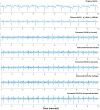A Novel Technique for Fetal ECG Extraction Using Single-Channel Abdominal Recording
- PMID: 28245585
- PMCID: PMC5375743
- DOI: 10.3390/s17030457
A Novel Technique for Fetal ECG Extraction Using Single-Channel Abdominal Recording
Abstract
Non-invasive fetal electrocardiograms (FECGs) are an alternative method to standard means of fetal monitoring which permit long-term continual monitoring. However, in abdominal recording, the FECG amplitude is weak in the temporal domain and overlaps with the maternal electrocardiogram (MECG) in the spectral domain. Research in the area of non-invasive separations of FECG from abdominal electrocardiograms (AECGs) is in its infancy and several studies are currently focusing on this area. An adaptive noise canceller (ANC) is commonly used for cancelling interference in cases where the reference signal only correlates with an interference signal, and not with a signal of interest. However, results from some existing studies suggest that propagation of electrocardiogram (ECG) signals from the maternal heart to the abdomen is nonlinear, hence the adaptive filter approach may fail if the thoracic and abdominal MECG lack strict waveform similarity. In this study, singular value decomposition (SVD) and smooth window (SW) techniques are combined to build a reference signal in an ANC. This is to avoid the limitation that thoracic MECGs recorded separately must be similar to abdominal MECGs in waveform. Validation of the proposed method with r01 and r07 signals from a public dataset, and a self-recorded private dataset showed that the proposed method achieved F1 scores of 99.61%, 99.28% and 98.58%, respectively for the detection of fetal QRS. Compared with four other single-channel methods, the proposed method also achieved higher accuracy values of 99.22%, 98.57% and 97.21%, respectively. The findings from this study suggest that the proposed method could potentially aid accurate extraction of FECG from MECG recordings in both clinical and commercial applications.
Keywords: adaptive noise cancellation (ANC); non-invasive FECG extraction; single abdominal channel; singular value decomposition (SVD); smooth window (SW).
Conflict of interest statement
The authors declare no conflict of interest.
Figures







References
-
- Lewis M.J. Review of electromagnetic source investigations of the fetal heart. Med. Eng. Phys. 2003;25:801–810. - PubMed
-
- Cohen W.R., Ommani S., Hassan S., Mirza F.G., Solomon M., Brown R., Schifrin B.S., Himsworth J.M., Hayes-Gill B.R. Accuracy and reliability of fetal heart rate monitoring using maternal abdominal surface electrodes. Acta Obstet. Gynecol. Scand. 2012;91:1306–1313. doi: 10.1111/j.1600-0412.2012.01533.x. - DOI - PubMed
-
- Naeye R.L., Peters E.C. Antenatal hypoxia and low IQ value. Am. J. Dis. Child. 1987;141:50–54. - PubMed
MeSH terms
LinkOut - more resources
Full Text Sources
Other Literature Sources

